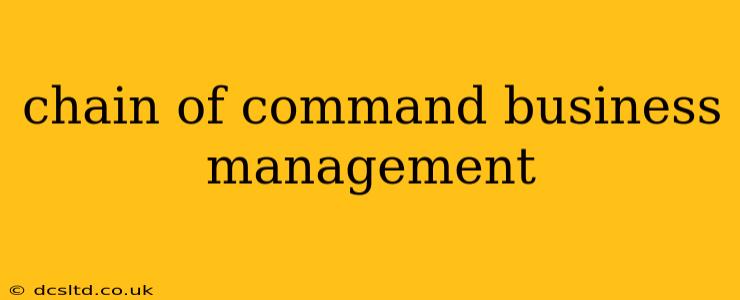The chain of command is a crucial element of effective business management. It defines the hierarchical structure within an organization, outlining the flow of authority and responsibility from top to bottom. A well-defined chain of command ensures clear communication, accountability, and efficient decision-making. However, a poorly structured or inflexible chain of command can stifle innovation, lead to bottlenecks, and ultimately hinder the organization's success. This article delves into the intricacies of the chain of command, exploring its benefits, challenges, and modern adaptations.
What is the Chain of Command?
The chain of command is the formal line of authority in an organization. It dictates who reports to whom, establishing a clear path for instructions, information, and accountability to flow. This typically follows a hierarchical structure, with higher-level managers overseeing lower-level employees. Think of it as a pyramid, with the CEO at the apex and employees at the base. Each level has specific responsibilities and reporting lines. Understanding this structure is vital for efficient operation and maintaining order within the company.
Why is the Chain of Command Important?
A clearly defined chain of command offers several significant advantages:
- Clear Accountability: Everyone knows who is responsible for what, making it easier to assign tasks, track progress, and address issues.
- Efficient Communication: Information flows smoothly through established channels, reducing confusion and delays.
- Improved Coordination: Teams work together more effectively when they understand their roles and reporting structures.
- Reduced Conflict: Clear lines of authority minimize ambiguity and potential disputes over responsibilities.
- Consistent Decision-Making: Decisions are made at the appropriate levels, ensuring consistency and alignment with overall organizational goals.
What are the Disadvantages of a Rigid Chain of Command?
While the chain of command offers many benefits, an overly rigid or inflexible structure can present challenges:
- Slow Decision-Making: In hierarchical structures, decisions often need to go through multiple layers of approval, leading to delays.
- Lack of Innovation: Employees may be hesitant to take initiative or suggest new ideas for fear of exceeding their authority.
- Communication Bottlenecks: Overly hierarchical structures can create bottlenecks, where information is delayed or distorted as it travels through multiple levels.
- Reduced Employee Morale: Employees may feel undervalued or unheard if they lack opportunities for input or feedback.
- Stifled Creativity and Collaboration: The emphasis on hierarchy can hinder collaborative efforts and the free flow of ideas.
How to Effectively Manage the Chain of Command?
Effective management of the chain of command requires careful consideration and a balanced approach:
- Clearly Define Roles and Responsibilities: Ensure that each position has a clear job description outlining responsibilities and reporting lines.
- Promote Open Communication: Encourage upward and downward communication to ensure that information flows freely and employees feel heard.
- Empower Employees: Delegate authority to lower-level employees whenever possible, fostering a sense of ownership and responsibility.
- Regularly Review and Update: The chain of command should be reviewed and updated periodically to reflect changing organizational needs and structures.
- Foster a Collaborative Culture: Encourage collaboration and teamwork despite the hierarchical structure.
How does the chain of command differ across various organizational structures?
The implementation of the chain of command varies significantly depending on the organizational structure. Flat organizations have shorter chains of command, promoting faster decision-making and greater employee empowerment. Conversely, tall organizations have longer chains of command, resulting in slower decision-making and a greater potential for communication issues.
What are some modern adaptations of the chain of command?
In today's dynamic business environment, many organizations are adapting traditional chain of command models. These adaptations include:
- Matrix Structures: Employees report to multiple managers, fostering collaboration across different departments.
- Flatter Hierarchies: Organizations are reducing the number of management layers to improve efficiency and communication.
- Decentralized Decision-Making: Authority is delegated to lower levels to empower employees and speed up decision-making.
- Cross-functional Teams: Teams are formed from individuals across different departments, breaking down traditional hierarchical barriers.
What are the implications of a poorly defined chain of command?
A poorly defined chain of command can lead to chaos and inefficiency. Responsibilities may be unclear, resulting in duplicated efforts or tasks falling through the cracks. Communication breakdowns can lead to misunderstandings, conflict, and project delays. Ultimately, a poorly defined chain of command can significantly impact organizational performance and negatively affect employee morale.
By understanding the chain of command's principles, advantages, and limitations, businesses can create a structure that supports efficient operations, clear communication, and a highly motivated workforce. Adapting to modern best practices ensures the organization remains agile and responsive to the ever-changing business landscape.
